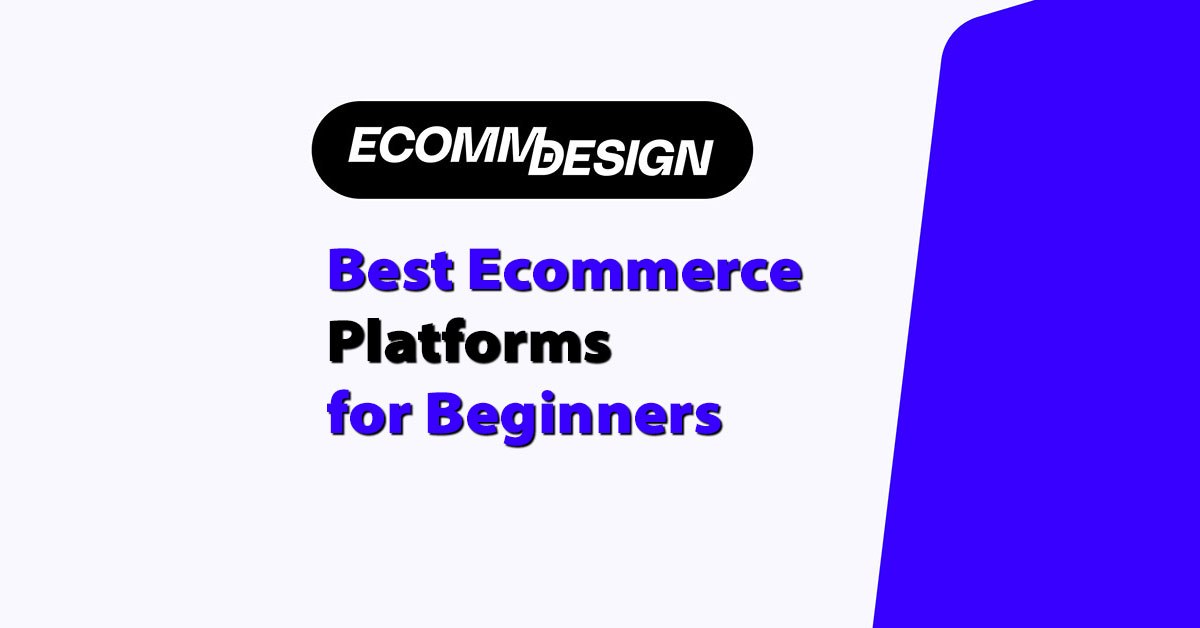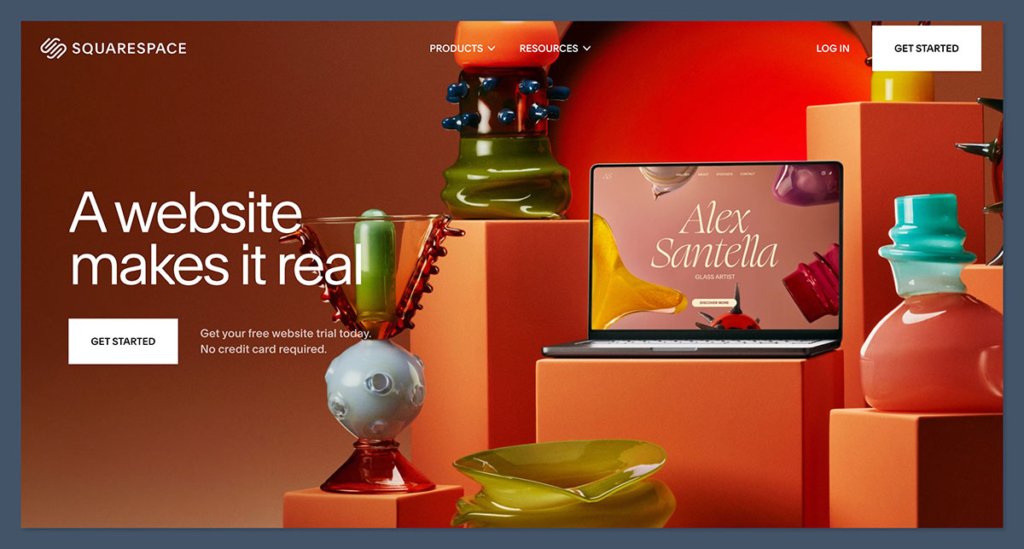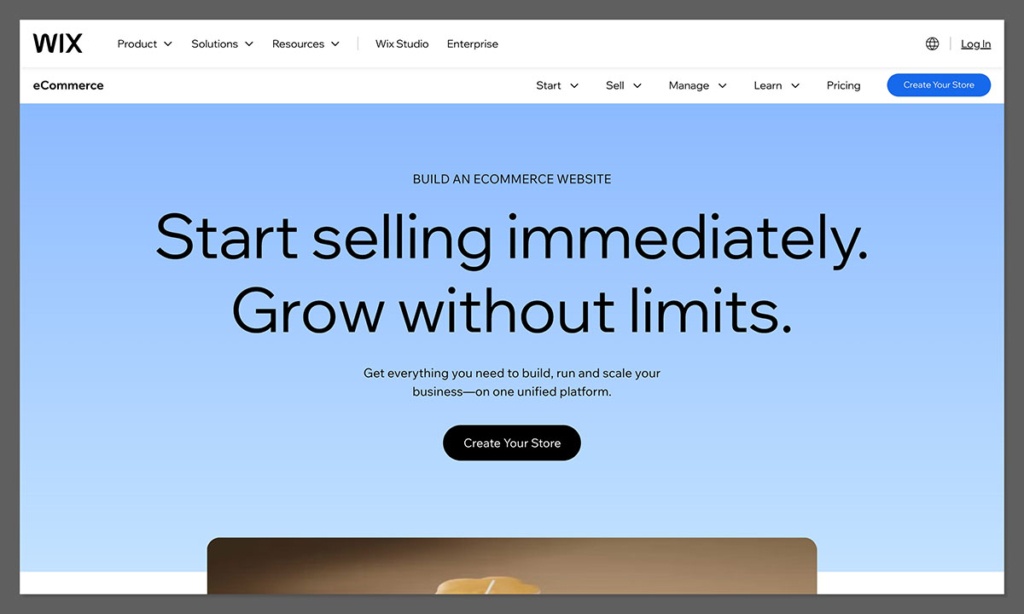
We tested and reviewed 15 ecommerce platforms to find out which ones make launching an online store easy for first-time sellers.
Our top picks combine ease of use, affordability, flexibility, and attractive design features—so you can start selling quickly, without needing technical skills.
Whether you’re launching a digital side hustle, a handmade product shop, or a print-on-demand store, there’s an ecommerce platform here to support your goals.
Our Top 5 Ecommerce Platforms for Beginners:
- Shopify – Best for selling online
- Squarespace – Best for stylish small stores
- Wix – Best for design flexibility
- Big Cartel – Best free option for artists
- Sellfy – Best for digital products
1. Shopify: Best Ecommerce Platform for Selling Online

| Rating | 4.8 / 5 |
|---|---|
| 💰 Starting Price | $29/month |
| Best For | Beginners who want to start and grow an online store, all in one place |
Shopify is the most popular ecommerce platform on the market—and for good reason. It’s designed specifically for online selling, giving you access to a full suite of tools for launching, managing, and scaling your store.
I found Shopify’s onboarding smooth and intuitive. Their AI setup assistant asked me about my products and created a basic storefront within minutes.
It wasn’t flashy out of the gate, but it gave me a working store that I could quickly customize using free themes and apps.
✔️ Pros
- Sell unlimited products (physical and digital)
- Access to hundreds of ecommerce apps
- Easy to connect to marketplaces like Amazon and Instagram
- Great SEO and performance tools
❌ Cons
- Most themes are paid ($140+)
- Editor feels slightly restrictive compared to others
- Limited design flexibility without coding
Pricing Breakdown
| Plan | Monthly Price | Key Features |
|---|---|---|
| Basic | $29 | Best for new stores |
| Shopify | $105 | Pro reports and better analytics |
| Advanced | $399 | Custom reporting and shipping |
The Basic plan includes everything you need to launch: product pages, shopping cart, payment processing, discount codes, and basic analytics.
Moving up to the Shopify plan unlocks detailed reporting and more staff accounts, while the Advanced tier adds features like third-party shipping rate calculations and custom reports—ideal for stores with complex logistics or higher volume.
Bottom Line: Should You Use Shopify?
Shopify is best for growing ecommerce businesses because of its full suite of sales features.
Smaller stores may find it slightly overpowered at first, but if you’re ready to take your store seriously and scale, Shopify has the infrastructure to support long-term success.
2. Squarespace: Best for Design-Focused Stores

| Rating | 4.5 / 5 |
|---|---|
| 💰 Starting Price | $16/month |
| Best For | Creatives and design-focused users who want a beautiful storefront |
Squarespace is one of the easiest platforms I’ve tested for building a store that looks professionally designed.
The drag-and-drop editor uses a clean grid system, making it hard to mess up layouts. I set up a store with only four products and was able to customize fonts, color palettes, and animations without touching any code.
It’s not built for high-volume stores, but if your focus is on showcasing a few great products with beautiful images, Squarespace hits the mark.
✔️ Pros
- Stunning templates with mobile optimization
- Built-in email marketing and analytics
- Excellent support for booking and digital services
- Easy-to-use interface, even for beginners
❌ Cons
- Less flexible than Wix
- No free plan
- Limited third-party extensions
Pricing Breakdown
| Plan | Monthly Price | Ecommerce Features |
|---|---|---|
| Business | $23 | Basic ecommerce functionality |
| Basic Commerce | $27 | No transaction fees |
| Advanced Commerce | $49 | Subscriptions and shipping tools |
The Business plan allows you to sell online with a 3% transaction fee, making it best for testing the waters.
Basic Commerce removes those transaction fees and includes features like customer accounts, point-of-sale, and inventory tracking.
Advanced Commerce unlocks advanced features like abandoned cart recovery, subscriptions, and real-time shipping rates.
Bottom Line: Should You Use Squarespace?
Squarespace is ideal for visually driven brands that want their store to look polished without investing in custom design.
It’s not the most flexible or scalable solution, but it’s an excellent option for creators and small businesses looking for simplicity and great design out of the box.
3. Wix: Best for Customization and Flexibility

| Rating | 4.3 / 5 |
|---|---|
| 💰 Starting Price | $17/month |
| Best For | Beginners who want full creative control over their store’s design |
Wix offers the most flexibility of any builder I tested. The drag-and-drop editor gives you near-complete control over page layouts, making it easy to create a site that looks and feels unique.
Wix also includes an AI website builder that generates a ready-made site based on a short quiz.
It got me 70% of the way there in a few minutes. I then adjusted the design with custom blocks, animations, and extra pages.
You do need to be a bit more patient—it’s not as streamlined as Squarespace—but the trade-off is creative freedom.
✔️ Pros
- 800+ templates for various industries
- Complete design flexibility
- Strong app marketplace
- Built-in marketing and SEO tools
❌ Cons
- Can’t change template after publishing
- Learning curve with the editor
- Slower load speeds than Shopify or Squarespace
Pricing Breakdown
| Plan | Monthly Price | Ecommerce Capable? |
|---|---|---|
| Core | $29 | Yes |
| Business | $36 | Advanced features |
| Business Elite | $159 | Enterprise-ready |
The Core plan gets you started with basic ecommerce tools, secure checkout, and product listings.
The Business tier adds more storage, customer support tools, and additional marketing features.
Business Elite is tailored for larger stores needing advanced bandwidth, analytics, and premium support.
Bottom Line: Should You Use Wix?
Wix is a great choice if branding and customization are a top priority.
It offers more design control than any other beginner-friendly builder. Just know that with freedom comes complexity—you’ll want to spend a little more time tweaking layouts to get everything just right.
4. Big Cartel: Best Free Option for Creators

| Rating | 4.0 / 5 |
|---|---|
| 💰 Starting Price | Free |
| Best For | Artists and makers selling a small number of products |
Big Cartel is designed for people who want to start small—really small.
If you’re an artist, illustrator, or handmade product seller, it’s a simple and affordable way to sell online without monthly fees.
During testing, I found the interface to be refreshingly minimal. Setup only took about 10 minutes, and I could easily add product images, pricing, and checkout settings.
It doesn’t offer advanced features like Shopify, but that’s not the point. It’s there to help you start without overwhelm.
✔️ Pros
- Free plan available for up to 5 products
- No transaction fees
- Simple interface for quick setup
- Clean, minimalist templates
❌ Cons
- Limited features for scaling
- Few integrations
- Basic design customization
Pricing Breakdown
| Plan | Monthly Price | Product Limit |
|---|---|---|
| Free | $0 | 5 products |
| Platinum | $9.99 | 50 products |
| Diamond | $19.99 | 500 products |
The Free plan includes core features like checkout and theme customization for up to 5 products.
Platinum introduces inventory tracking and custom domains, while Diamond supports bulk editing, Google Analytics, and higher product counts—without bloating the dashboard with extras.
Bottom Line: Should You Use Big Cartel?
Big Cartel is ideal for creatives who want to sell a small number of items without a financial commitment.
It’s not built for long-term growth, but for first-time sellers testing the waters, it’s a refreshingly low-pressure place to start.
5. Sellfy: Best for Digital Products

| Rating | 4.0 / 5 |
|---|---|
| 💰 Starting Price | $29/month |
| Best For | Digital creators and subscription-based businesses |
Sellfy is a platform I recommend if you’re focused on selling digital goods like ebooks, video courses, music, or design files.
It’s also a good fit for creators offering memberships, pay-what-you-want pricing, and subscription services.
What stood out during testing was how fast you can launch. I uploaded a PDF, added a cover image, and had a working checkout page in under 20 minutes.
The platform also auto-generates license keys and download links, which saves time and avoids headaches.
✔️ Pros
- Optimized for digital and subscription products
- Supports pay-what-you-want pricing
- No need for external plugins
- Accepts multiple currencies
❌ Cons
- Limited design flexibility
- No built-in blogging tools
- Templates feel basic
Pricing Breakdown
| Plan | Monthly Price | Sales Limit per Year |
|---|---|---|
| Starter | $29 | $10,000 |
| Business | $79 | $50,000 |
| Premium | $159 | Unlimited |
The Starter plan includes product uploads, discount codes, and customizable storefronts.
The Business tier adds upsells, cart recovery, and email marketing features.
Premium removes all limits and is best for creators managing large audiences or recurring sales.
Bottom Line: Should You Use Sellfy?
Sellfy is a focused, beginner-friendly solution for selling digital products. It skips the fluff and gets straight to selling.
If you’re a course creator, designer, or content producer, it’s one of the simplest ways to monetize your work online.
How to Choose the Right Ecommerce Platform
If you’re a beginner, choosing the right ecommerce platform isn’t just about price—it’s about finding the right fit for your skill level, product type, and business goals.
Here are the key factors we recommend focusing on when making your decision:
| Feature | What to Look For |
|---|---|
| Ease of Use | A simple, guided setup process that doesn’t require any coding knowledge |
| Design Options | Templates that are mobile-friendly and easy to customize |
| Product Support | Ability to sell physical or digital products, or offer subscriptions |
| Features & Tools | Inventory tracking, discount codes, shipping integrations, email marketing |
| Pricing | Clear, scalable pricing with no surprise transaction or app fees |
| Support | Help center articles, live chat, or email support when you get stuck |
| Scalability | Ability to upgrade as your store grows, without rebuilding from scratch |
| SEO Capabilities | Editable meta tags, clean URLs, and fast page speed to rank on Google |
| App Integrations | Access to a marketplace of add-ons or plugins for marketing and automation |
We also recommend taking advantage of free trials. Most platforms let you test out features and editors before committing.
This gives you a good sense of whether the builder feels intuitive—and if it can grow with your business.
How We Test Ecommerce Platforms
Our methodology is built on real-world testing, side-by-side comparisons, and feature-by-feature evaluations.
We look at what matters most to beginners—especially those launching stores with no technical background.
Each platform is tested based on the following criteria:
| Category | Weight | What We Evaluate |
|---|---|---|
| Ease of Use | 30% | Can beginners set up, launch, and manage a store independently? |
| Features | 25% | Built-in selling tools, product options, digital support |
| Design | 15% | Template quality, design freedom, mobile responsiveness |
| Pricing | 10% | Value for money across tiers, hidden fees, free plan options |
| Support | 10% | Availability and quality of customer support |
| Scalability | 10% | How easily the platform grows with your store |
We spent over 300 hours testing 15 ecommerce platforms. That included building demo stores from scratch, using onboarding wizards, comparing template libraries, testing checkout flows, and exploring the built-in tools and app ecosystems that each platform offers.
We evaluated how intuitive each builder felt to use, how customizable the design options were, and how quickly someone could go from “new account” to “ready to sell.”
But we didn’t stop at test environments.
As part of our ongoing curation at Ecomm.Design, we also analyzed the live ecommerce stores featured in our gallery—particularly small shops and independent brands that are either just starting out or intentionally staying small and design-focused.
This gave us a clear view of which platforms real store owners are choosing when aesthetics, branding, and usability are top priorities.
We tracked platform usage across hundreds of stores and found strong trends in platform preference among new and smaller brands.
Many favored tools that balanced ease of use with design flexibility—especially those offering modern, mobile-optimized templates out of the box.
This combination of hands-on testing and real-world observation helps ensure that our recommendations aren’t just practical in theory—they’re already working for store owners building beautiful, high-performing ecommerce sites today.
Final Verdict: Which Ecommerce Platform Do I Recommend?
Each ecommerce platform on this list has strengths—and which one is best for you depends on what you’re selling and how you want to grow.
Here’s a quick recap:
| Platform | Best For |
|---|---|
| Shopify | Full-featured online stores with room to scale |
| Squarespace | Beautiful, small-to-medium stores with a visual edge |
| Wix | Beginners who want total design control |
| Big Cartel | Artists and makers just starting out |
| Sellfy | Digital creators and subscription-based businesses |
If you want my top recommendation?
Go with Shopify if you plan to sell physical products and want a platform that can grow with your business. It has the best all-in-one toolset for beginners who are ready to take ecommerce seriously.
But if your focus is on branding, design, or digital content, you may be better off with one of the other options above.
All five are viable for beginners—the real key is knowing your priorities and picking the platform that supports them best.






